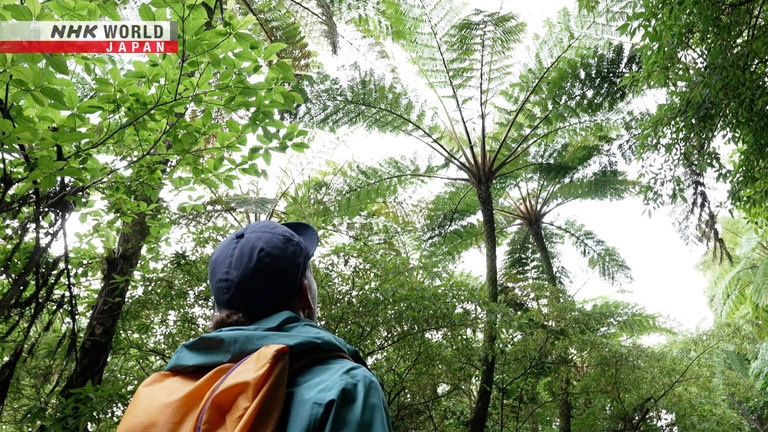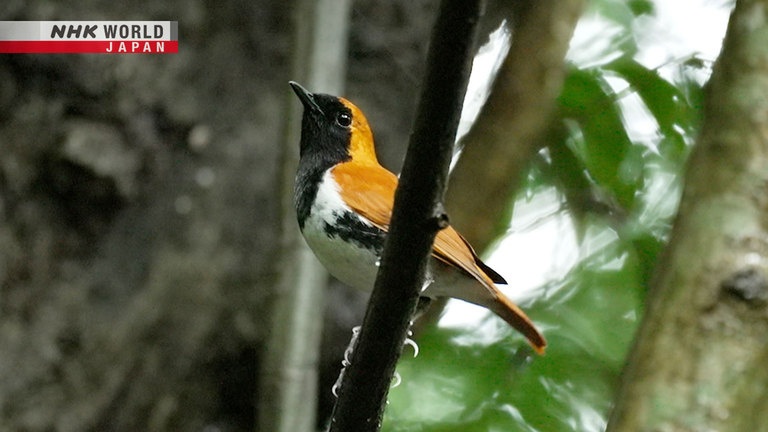The Wild Life in One-of-a-Kind Amami
Amami Oshima Islands, designated as a Natural World Heritage site in 2021, is home to rich biodiversity, including many endemic species. For instance, the Amami rabbit is a living remnant of ancient hares, found only on Amami Oshima and Tokunoshima islands. In this episode of Journeys in Japan, actor Michael Keida heads deep into the forest in search of the subtropical island's rare plant and wildlife. And he meets people who share their knowledge of the forests and sea.



Transcript
"Journeys in Japan"
Amami Oshima.
This lush island carpeted in subtropical rainforests
nurtures a unique biodiversity found nowhere else in the world.
Michael Keida is an actor and organic farmer.
He meets islanders who have long lived close to the land and the sea.
Michael.
Long time. How have you been?
There's one. On the left.
He spots a nocturnal rabbit with ancient lineage.
On "Journeys in Japan,"
Michael ventures deep into the heart of Amami Oshima.
The Wild Life in One-of-a-Kind Amami
Amami is a subtropical island
situated between Kyushu and Okinawa's main island.
That's 1,300 kilometers, and a world away from Tokyo.
Here I am in Amami Oshima,
a place that's recently become a Natural World Heritage site.
I've been in Amami Oshima so many times
and it's a place that I hold very close to my heart.
I usually go take a dive in the ocean,
either going scuba diving or surfing.
But it's not due to its beautiful ocean it became a Natural Heritage site.
It's due to its deep and lush forest, a place I've yet to discover.
Michael gets to discover this world
with noted photographer Hamada Futoshi
who has been documenting Amami for over 40 years.
- The new leaves are beautiful.
- This is a great season.
- Chicks are hatched at this time of year, right?
- Yes, the forest is full of them.
Akahige singing.
They're lovely birds with lovely voices.
We can hear them but can't see them.
The Akahige.
This robin can only be encountered here and on neighboring islands.
Amami, with its many endemic feathered species,
is a birdwatcher's paradise.
The rarest bird in Amami is the Otora-tsugumi.
The thrush was threatened with extinction,
but its population is recovering.
They build nests in this forest.
- Their camouflage is good.
- If they don't move, we won't find them.
The Otora-tsugumi is a large thrush found only on this island.
Even though their numbers are rising, they are still endangered.
Mt. Yuwandake, the tallest peak
among the areas' four designated Natural World Heritage sites
that include Okinawa.
This uninhabited zone holds the key
as to why so many rare species are found on Amami.
Wow! That's beautiful.
Is this a popular waterfall?
There are many like this in Amami.
So, it doesn't have a name.
In Amami, it rains a lot.
Thanks to the rain...
The forests thrive and nurture living things.
It's amazing, this plant.
The world's largest tree fern called Hikage-hego.
It's the symbol of Amami.
Yeah, when I was a kid, I loved dinosaur illustrations,
and this is what it looked like.
It reminds me of that.
Ferns, including the Hikage-hego,
thrived on the planet in the Paleozoic era about 300 million years ago.
In Amami, these ancient plants still abound.
It feels great walking through the forest here.
I'm used to it being really hot and sweaty in Amami Oshima,
but the air here, it's cool.
It's got moisture in it but not humid.
It just feels really nice, even in this outfit.
Not a drop of sweat.
Oh, Michael.
This is a rare plant.
This is the Miyabi-kan-aoi.
Its seeds are carried by ants.
So, it takes ages until the seeds are dispersed.
Miyabi-kan-aoi, an evergreen perennial herb,
is only found on Mt. Yuwandake.
It evolved independently of Kan-aoi,
left behind on the mountain in ancient times.
The summit is a rich habitat of many endemic plants.
Here we are.
I've never had a chance to see Amami Oshima from this vantage point before.
What's behind the many endemic species on Amami?
Let's look at the islands' origins.
About 12 million years ago,
Amami was contiguous with the Eurasian Continent.
But, due to rising sea levels,
it broke off leaving ancient species behind.
And they followed a unique evolutionary path.
The geographically isolated nature of Amami Oshima
changed the life of one artist.
Tanaka Isson is known as Japan's Paul Gauguin.
Tanaka Isson was recognized as a talented artist from childhood.
He was called a genius of the Nanga style.
This is what I always think of
when I think of traditional Japanese paintings.
You know, this tall print and these kinds of flowing lines.
It's very beautiful and I particularly love Wisteria flowers.
That's incredible.
Tanaka was a prodigy, winning an art competition at age seven.
Tanaka painted this when he was 18.
How can I say this...
I feel something like his teenage moodiness.
These were painted in Amami.
Tanaka distanced himself from the mainstream art scene,
constantly pursuing new paths in painting.
At a crossroads in his career, he moved to Amami Oshima when he was 50.
Here, he developed his rich colorful style
while supporting himself through dyeing work.
They feel a little different from the earlier work.
They are tranquil.
This is one of his masterpieces.
It made us locals realize, we were only seeing our forests from the outside.
So, through his eyes, the locals reassessed Amami's nature.
Yes, exactly.
There's really quite a difference between his original drawings,
or his original paintings and this.
It just feels so peaceful. So connected with nature.
And I suppose that maybe after coming to Amami Oshima,
he had a change spiritually within his artwork.
Amami has many seasonal festivals.
March 3rd on the Lunar calendar,
or late April in the Gregorian, is one of them.
- What is going on?
- This is a beach opening ceremony.
In Amami, Sangatsu-sanchi,
or March 3 in the lunar calendar, is a day for rest.
They are praying for safety.
Parents with infants under one year old
bless their little feet in the waters,
wishing for healthy growth and well-being.
- How old is your baby?
- Three months.
- Is this the little one's first time at the sea?
- It is.
Isn't it cold? You have a great smile.
Hi, Nakamura! I brought along a friend.
Long time.
Do you know each other?
Michael.
How have you been?
We have been friends forever.
In Amami, today is a day for everyone to enjoy the beach.
There is a legend that if you don't go to the beach today,
you will become an owl.
I don't want to become an owl.
So, I went out and caught some fish.
To Sangatsu-sanchi and our reunion with Michael, cheers!
Try the sashimi, starting with the Ishigakidai first.
The freshness is just incredible.
The texture of it,
it's just kind of chewy and you can't really bite into it,
but it's got absolutely no fishiness to it.
Really delicate flavor, it's so good.
Why is there such a variety of fish
in the sea around Amami?
We have a saying that Amami's ocean exists thanks to our mountains...
and people exist thanks to community.
Both the ocean and people exist thanks to the surrounding environment.
Our ancestors taught us to protect the mountains
to protect the rich ocean.
Amami is blessed with the beautiful ocean, mountains, and people.
Amami's forests, which have been guarded for generations,
pulse with life day and... night.
We are going into the night forest.
I'm a bit scared, but excited.
And the fog is deep.
Half excited and half scared.
A Ryukyu scops owl.
Amami is the northern limit of its habitat.
They silently attack their prey, mostly small animals...
- A lot of different frogs are croaking.
- They are very lively.
It is a little mysterious.
What is this?
It's an Otton frog.
The Otton-gaeru is the area's largest frog,
growing to about 14 centimeters.
Its egg laying season has begun.
The endemic Amami-ishikawa-gaeru
considered to be Japan's most beautiful frog.
It is also laying eggs.
Amazing.
The Shiriken-imori lizards feed on insects and earthworms.
That guy came to eat frogs.
It's a venomous Hime-habu waiting to capture its prey.
This food chain ecosystem, which developed near water at night,
consists entirely of endemic species.
It is a remarkable phenomenon of Natural World Heritage site,
Amami Oshima.
- Where next?
- We are off to look for Amami rabbits.
This 150-year-old geography journal, featuring Amami,
shows the islands' black rabbit.
But it wasn't until later that the animal's rarity was recognized.
An American explorer returned home with Amami rabbit specimens.
In 1904, research revealed
that the species was single-genus, single-species,
meaning it is a living remnant of an ancient species.
The discovery stunned the world.
You look for the rabbits by car...
- What do they do by day?
- They rest in their burrows.
- What are they like?
- They are holes or caves.
At night, rabbits are drawn to the forest roads.
They eat and leave droppings along them.
For the first time ever, Hamada succeeded in capturing the interactions
between a mother and her kit in 1994.
The photographer has been acknowledged with many awards worldwide,
including from the Smithsonian National Museum of Natural History.
We will begin seeing rabbits after the curve ahead.
Rabbit droppings can be found from around here.
Look! Just in front of us.
It is so still. It's eating something.
It's not wary at all.
It's so cute.
This is very rare.
Hi. Hi.
The Amami rabbit is defined by its large head,
small eyes, and short ears,
just like the ancient rabbits
who lived in forests before adapting to grasslands.
The estimated population of the Amami rabbit
is in the tens of thousands.
It is a precious living fossil with no living relatives in the world.
Amami Oshima has been a very special place to me for over a decade.
Every time I come here, I am in awe of its natural beauty,
the warmth of the locals
and a sense that time just slows down here.
But until now, I only knew half
of what makes this island so unique.
I never realized
that this deep blue wonderland behind me
was thanks to the mountainous landscape
covered in lush forest.
Now I know why the locals here
have a deep sense of abundance
and embrace life with limitless warmth
and gives me another reason to return,
love and appreciate this gem in the Pacific.
The one-of-a-kind, Amami Oshima.
From Tokyo to Amami Oshima,
direct flights take about two and a half hours.
Flights via Kagoshima are also available.